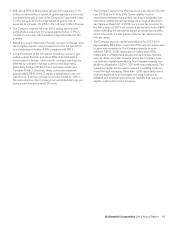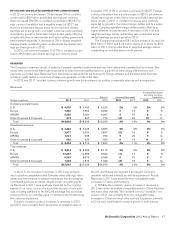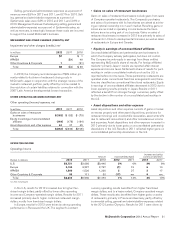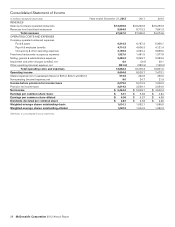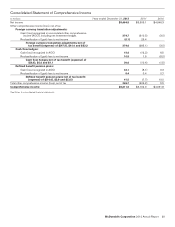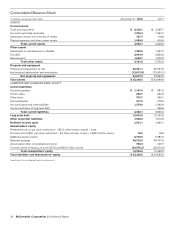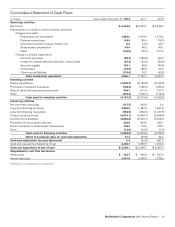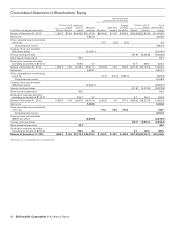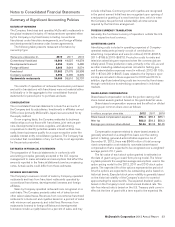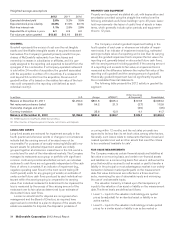McDonalds 2012 Annual Report Download - page 27
Download and view the complete annual report
Please find page 27 of the 2012 McDonalds annual report below. You can navigate through the pages in the report by either clicking on the pages listed below, or by using the keyword search tool below to find specific information within the annual report.
The Company’s net asset exposure is diversified among a
broad basket of currencies. The Company’s largest net asset
exposures (defined as foreign currency assets less foreign cur-
rency liabilities) at year end were as follows:
Foreign currency net asset exposures
In millions of U.S. Dollars 2012 2011
Euro $6,692 $5,905
Australian Dollars 2,450 2,409
Canadian Dollars 1,319 1,224
British Pounds Sterling 1,117 726
Russian Ruble 651 594
The Company prepared sensitivity analyses of its financial
instruments to determine the impact of hypothetical changes in
interest rates and foreign currency exchange rates on the
Company’s results of operations, cash flows and the fair value of
its financial instruments. The interest rate analysis assumed a one
percentage point adverse change in interest rates on all financial
instruments, but did not consider the effects of the reduced level
of economic activity that could exist in such an environment. The
foreign currency rate analysis assumed that each foreign currency
rate would change by 10% in the same direction relative to the
U.S. Dollar on all financial instruments; however, the analysis did
not include the potential impact on revenues, local currency prices
or the effect of fluctuating currencies on the Company’s antici-
pated foreign currency royalties and other payments received in
the U.S. Based on the results of these analyses of the Company’s
financial instruments, neither a one percentage point adverse
change in interest rates from 2012 levels nor a 10% adverse
change in foreign currency rates from 2012 levels would materi-
ally affect the Company’s results of operations, cash flows or the
fair value of its financial instruments.
LIQUIDITY
The Company has significant operations outside the United
States where we earn over 60% of our operating income. A sig-
nificant portion of these historical earnings are considered to be
indefinitely reinvested in foreign jurisdictions where the Company
has made, and will continue to make, substantial investments to
support the ongoing development and growth of our international
operations. Accordingly, no U.S. federal or state income taxes
have been provided on the undistributed foreign earnings. The
Company’s cash and equivalents held by our foreign subsidiaries
totaled approximately $2.1 billion as of December 31, 2012. We
do not intend, nor do we foresee a need, to repatriate these funds.
Consistent with prior years, we expect existing domestic cash
and equivalents, domestic cash flows from operations, annual
repatriation of a portion of the current period’s foreign earnings,
and the issuance of domestic debt to continue to be sufficient to
fund our domestic operating, investing, and financing activities.
We also continue to expect existing foreign cash and equivalents
and foreign cash flows from operations to be sufficient to fund
our foreign operating, investing, and financing activities.
In the future, should we require more capital to fund activities
in the United States than is generated by our domestic oper-
ations and is available through the issuance of domestic debt, we
could elect to repatriate a greater portion of future periods’ earn-
ings from foreign jurisdictions. This could also result in a higher
effective tax rate in the future.
While the likelihood is remote, to the extent foreign cash is
available, the Company could also elect to repatriate earnings
from foreign jurisdictions that have previously been considered to
be indefinitely reinvested. Upon distribution of those earnings in
the form of dividends or otherwise, the Company may be subject
to additional U.S. income taxes (net of an adjustment for foreign
tax credits) which could result in a use of cash. This could also
result in a higher effective tax rate in the period in which such a
determination is made to repatriate prior period foreign earnings.
Refer to the Income Taxes note to the consolidated financial
statements appearing elsewhere herein for further information
related to our income taxes and the undistributed earnings of the
Company’s foreign subsidiaries.
CONTRACTUAL OBLIGATIONS AND COMMITMENTS
The Company has long-term contractual obligations primarily in
the form of lease obligations (related to both Company-operated
and franchised restaurants) and debt obligations. In addition, the
Company has long-term revenue and cash flow streams that
relate to its franchise arrangements. Cash provided by operations
(including cash provided by these franchise arrangements) along
with the Company’s borrowing capacity and other sources of
cash will be used to satisfy the obligations. The following table
summarizes the Company’s contractual obligations and their
aggregate maturities as well as future minimum rent payments
due to the Company under existing franchise arrangements as of
December 31, 2012. See discussions of cash flows and financial
position and capital resources as well as the Notes to the con-
solidated financial statements appearing elsewhere herein for
further details.
Contractual cash outflows Contractual cash inflows
In millions Operating
leases Debt
obligations(1) Minimum rent under
franchise arrangements
2013 $ 1,352 $ 2,562
2014 1,259 $ 659 2,484
2015 1,130 1,168 2,382
2016 1,020 2,437 2,261
2017 918 1,053 2,130
Thereafter 6,844 8,273 17,047
Total $12,523 $13,590 $28,866
(1) The maturities reflect reclassifications of short-term obligations to long-term obliga-
tions of $1.5 billion, as they are supported by a long-term line of credit agreement
expiring in November 2016. Debt obligations do not include $42 million of noncash
fair value hedging adjustments or $217 million of accrued interest.
The Company maintains certain supplemental benefit plans
that allow participants to (i) make tax-deferred contributions and
(ii) receive Company-provided allocations that cannot be made
under the qualified benefit plans because of IRS limitations. At
December 31, 2012, total liabilities for the supplemental plans
were $493 million, and total liabilities for gross unrecognized tax
benefits were $482 million.
There are certain purchase commitments that are not recog-
nized in the consolidated financial statements and are primarily
related to construction, inventory, energy, marketing and other
service related arrangements that occur in the normal course of
business. The amounts related to these commitments are not
significant to the Company’s financial position. Such commit-
ments are generally shorter term in nature and will be funded
from operating cash flows.
McDonald’s Corporation 2012 Annual Report 25


